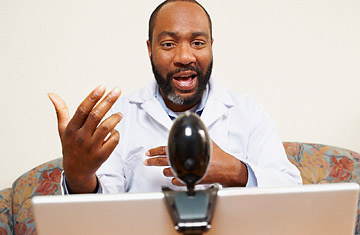
Kanina Chavez lives an hour away from Children's Hospital in Seattle and used to have to take a whole day off from work whenever her daughter, Rachel, had an appointment with a psychiatrist. Rachel was a teenager when she started treatment for bipolar disorder roughly six years ago. Back then, she and her mother had never heard of telepsychiatry. But now they're using real-time videoconferencing in Olympia, Wash., to make it easier for Rachel to remain in the care of experts in Seattle. During the videoconferencing sessions, her psychiatrist can monitor how Rachel is doing, and Kanina can sit beside her daughter and take notes on the recommended adjustments to her daughter's medications. "I was a little apprehensive about my daughter not being face to face with the doctor," says Chavez. "But the conversation was just as good as if we were in person."
Telepsychiatry is a growing trend in mental health, says Dr. Kathleen Myers, who treats Rachel up close and personal despite the 75 miles between them. As director of the telemental health service at Children's Hospital, she points to one of the benefits of a videoconference: unlike a phone call, it allows doctors to observe a patient's facial expressions and body language. "You can talk back and forth in real time — it's off by a millisecond — so you get immediate reactions," says Myers, who, with a $3 million grant from the National Institute of Mental Health (NIMH), is conducting the first large federally funded randomized clinical trial to determine the effectiveness of telemental health in treating mental-health problems in childhood.
The rise in telepsychiatry has come largely out of need. According to the American Academy of Child and Adolescent Psychiatry (AACAP), between 7 million and 12 million youths suffer from mental, behavioral or developmental disorders. And a new nationally representative survey, funded in part by NIMH, indicates that 50% of the children in the U.S. who have certain mental disorders such as generalized anxiety disorder and depression are not being treated by a psychiatrist or other mental-health professional.
"There are not enough doctors to go around," says Dr. Martin Drell, head of child psychiatry for Louisiana State University's health-science center in New Orleans and AACAP's president-elect. For example, in Michigan's Upper Peninsula, the local hospital doesn't have a child psychiatrist, so doctors some six hours away, at Michigan State University in East Lansing, treat patients via videoconferencing. In South Carolina, a statewide telepsychiatry program established last summer has cut the average waiting period for a child to get a psychiatric consultation from several days (in part because many families in rural areas lack transportation to get to an urban hospital) to a few hours.
In addition to expanding the geographic reach of individual psychiatrists, videoconferencing can help cut down on some of the stigma of going to see a shrink. Students at Ball High School in Galveston, Texas, can now go to the school's health clinic and — without having to press a button or flip a switch — be face to face with a psychiatrist. "There is a flat-screen TV, and that's where they can see the clinician and talk in real time," says Dr. Fred Thomas, a psychiatric epidemiologist who heads community-based mental-health services and policy for the University of Texas Medical Branch, which now includes five telepsychiatry locations in Galveston. "The clinician has a remote and can move the camera around and zoom in on someone's face to see changes in expression or to see if someone is tearing up."
Oftentimes, according to Thomas, videoconferencing can reduce the anxiety of office visits for children and adolescents. "It's much easier to talk via a screen, especially with issues like anxiety disorders and sexual abuse," he says. "Students feel safe."
In Seattle, Myers is heading up the NIMH study that is specifically designed to determine whether expert psychiatric care through telemental health is more effective than treatment in a typical primary-care setting for children ages 6 to 12 who have attention-deficit/hyperactivity disorder.
So far, anecdotal evidence indicates that virtual psychiatry visits work just fine for children and adolescents. Perhaps it's a sign of the times, an era in which teens feel more comfortable in front of a camera than they do face to face. "Videoconferencing is part of their everyday existence — it's like texting or Skype," says Drell.
In New Orleans, Dr. Kristopher Kaliebe, an assistant professor at Louisiana State University who works with Drell, has telemed equipment set up in his home. Some of his time is spent videoconferencing with patients in a juvenile-detention center who have been diagnosed with such conditions as bipolar disorder, severe depression and posttraumatic stress disorder. "Once the conversation starts," he says, "the kids forget there's a screen between us."
